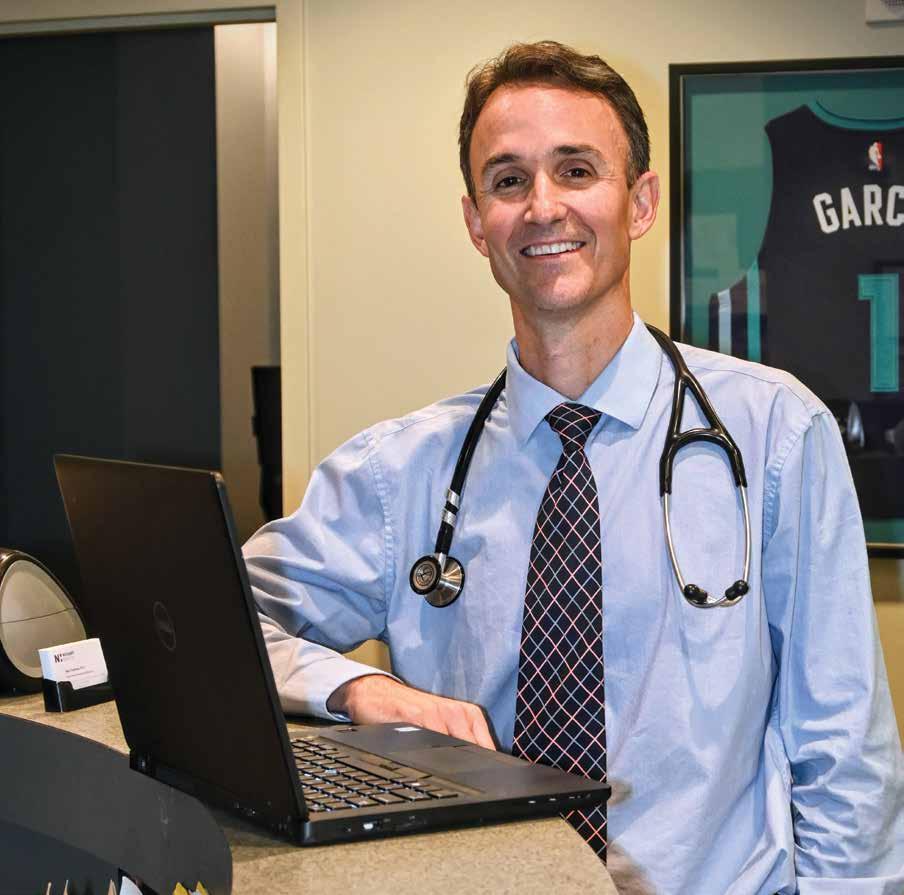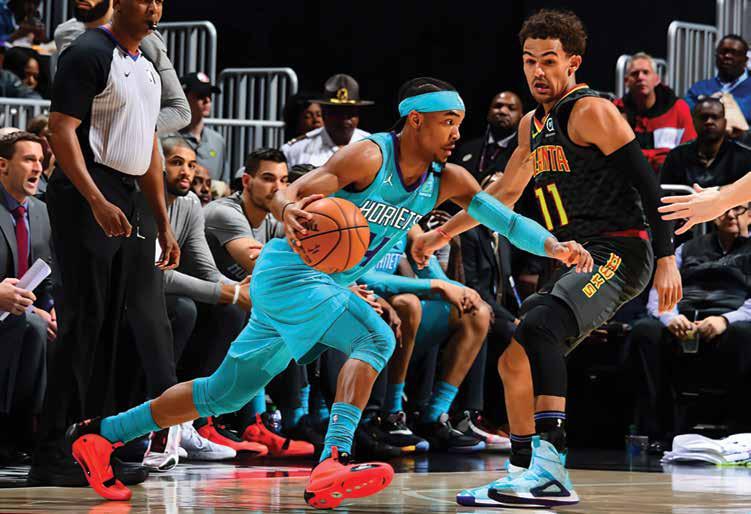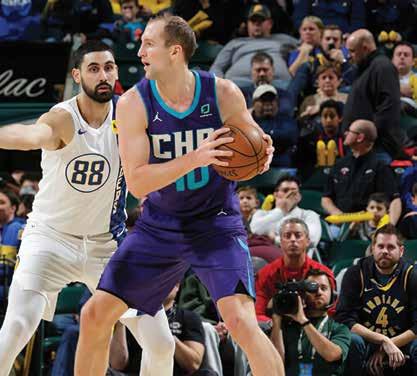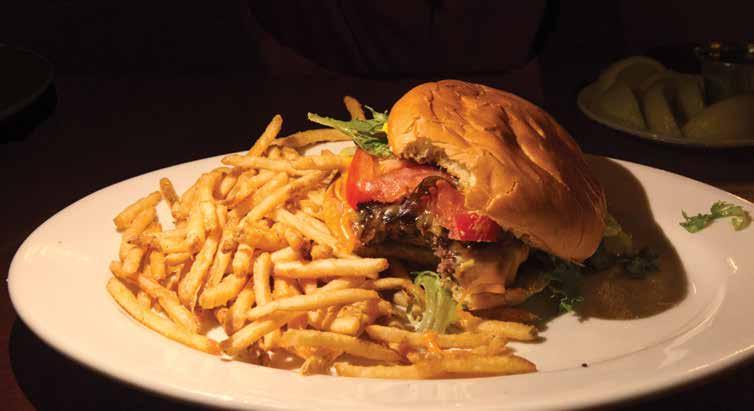
5 minute read
Game On
Off Court All Star HunTersville’s Dr. Joe Garcia keeps pro anD youTH aTHleTes safe anD HealTHy
by Martin Rose
Advertisement
photography by Martin Rose
Dr. Joe Garcia knew from seventh grade his calling was a sports medicine doctor. “I loved sports as a kid. And I always wanted to practice medicine,” says Dr. Garcia. He recalls reading about an injured NBA basketball star and his doctor’s role in recovery. “I told my dad that day I wanted to be a sports medicine doctor. I never wavered from that path.”
Today, he lives that dream out as Charlotte Hornets team physician. “I have a dream job,” he says. “I work for owner Michael Jordan. I meet hundreds of NBA players, coaches and staff. I travel the world.”
You’d think running a family and sports medicine practice at Novant Health Lakeside Family Physicians in Huntersville along with Hornets’ responsibility would be daunting, but Dr. Garcia also serves as team physician for the Charlotte Checkers hockey team, four Joe Gibbs race teams and seven high school athletic departments.
Charlotte Hornets player Devonte’ Graham faces off against the Atlanta Hawks’ Trae Young this past season.

photo courtesy of NBAE/Getty Images

all in THe family Medicine is a family tradition. His grandfather graduated from Spain’s University of Madrid Medical School in 1915. His father followed in 1956 and mom was a nurse.
Asked how many Hornets game he attends typically, he laughs, “By my count, I have attended 740 consecutive games. The only game I ever missed was in 2005 to attend my father’s funeral.”
His role on the team is vital. President of Basketball Operations & General Manager Mitch Kupchak calls Dr. Garcia “the key medical professional we cannot do without when it comes to the health and safety of the Hornets players and staff.”
THe curry connecTion Dr. Garcia started with the original Charlotte Hornets (now the New Orleans Pelicans) in 1997-98. The team ball boys were 8- and 9-year-olds Steph and Seth Curry. Yes, the same Currys now starring for the NBA’s Golden State Warriors and Dallas Mavericks, respectively. “Coach Dave Cowens would get so mad because those two were always dribbling a basketball when he was trying to talk to the players. Thump. Thump. Thump. It never stopped. They always had a ball,” says Dr. Garcia.
Reflecting on his years as team physician, Dr. Garcia is most thankful for the hundreds of amazing players and coaches he has met. He still keeps in touch with many. “People like to categorize NBA players as egotistic maniacs,” he says. “That’s just not the case. So many players are unbelievable human beings off the court, but they choose to avoid publicity and keep their good deeds private.
“I get attached to the players and their families,” continues Dr. Garcia. “I take care of their moms, kids, wives and girlfriends. House calls are the norm. My job is to have them ready to play and they know they can call me day or night, year-round.”
What’s the biggest change in his 23 NBA years? “The number of foreign players,” he says. “It went from almost zero to 20 percent. Pro scouts who used to only focus exclusively on U.S. colleges now scout the world for NBA talent.”
Pictured: Hornets player Bismack Biyombo dunks the ball. Dr. Joe Garcia watches the game carefully, checking for signs of injury in players.

Right: Hornets player Cody Zeller faces off against Indiana Pacers’ player Goga Bitadze.
safeTy DurinG a panDemic Dr. Garcia was crucial recently in creating a local bubble for the Charlotte Hornets to practice safely amid COVID-19. Players and coaches were housed at The Ballantyne Hotel in Charlotte, tested daily for COVID-19 and transported by bus to the arena for daily practice.
His advice for young athletes? “As parents we tend to specialize our kids in one sport early, but I suggest staying with multiple sports,” he says. “The greatest athletes play multiple sports in their youth. This trains different muscle groups and skills.
“Build in rest days for your kids,” he continues. “In the NBA we watch vital signs, symptoms and scores to determine when rest days are needed. We should do that for our kids. It’s okay to sit out a practice or even miss a game. We see a lot of repetitive motion injuries that could be avoided.”
GAME ON It’s Game Day!
photography by Martin Rose What the day of a Charlotte Hornets game looks like for Dr. Joe Garcia
Ongoing:
Address illness/injury from previous game for Hornets and opposing team.
Mid-day:
Speak with head athletic trainer to handle any health concerns with Hornets players and staff (about 30 people).
30 minutes before start:
Have someone talk to referees and opposing team about any health concerns.
Game time:
Ensure medics (ambulance) and radiology tech are onsite and ready. Dr. Garcia watches a game very differently than fans, always looking for injuries or illness.
Halftime:
Take care of first half problems in locker rooms of both teams.
Post-game:
Clear visiting team first because they are usually headed directly to airport to catch a flight. If an injury on their team is significant, we contact their team physician directly before they fly. Then home team players usually get treatments in training room, cold tub soaks, stretch and receive nutrition shakes.
Review each player with training staff and frequently connect with coaching staff and general manager to keep everyone informed. Communication is vital so that all members of team/coaches/management/owner are all on same page.
Meet with public relations personnel to control narratives of all significant injuries so the player has a plan before they meet with media after every game.
Dr. Garcia usually exits with trainer around 10-10:30 p.m. after starting the day in his office at 7:15 a.m., but he says it’s the greatest job in the world for someone like him. “I’m sad at end of each season. I also handle players’ family members and friends after games. This allows the Hornets players to focus more on their job instead of worrying about the health of a family member.”










